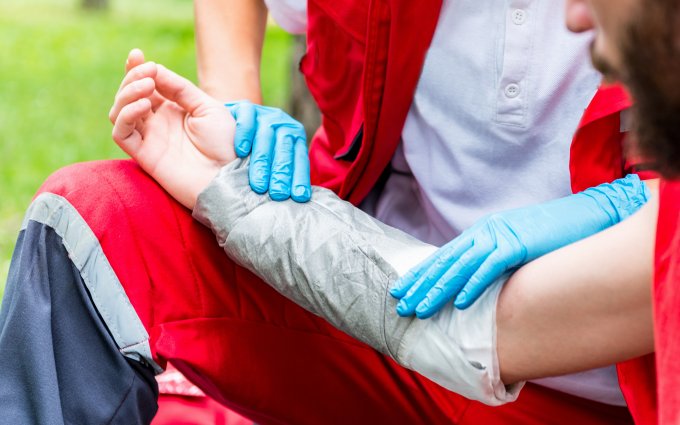08/01/2013

Some severe types of burn injuries require highly complex medical procedures and treatments lasting months or years in order to achieve satisfactory patient outcomes. Burn injuries are classified from first degree burns where epithelial damage of superficial skin occurs to fourth degree burns where it involve full-thickness destruction of the skin, subcutaneous tissue, with involvement of the underlying muscle, bone, or other deeper body structures. Preparing for the best outcomes requires understanding the type and degree of burn injury suffered by the injured person and applying the appropriate treatment quickly and timely. From a prevention standpoint, it can also benefit an organization to know that certain types of burns are often a function of the injured person’s line of work. According to the American Burn Association’s 2012 Fact Sheet:
Perhaps the most common type of burn injury treated in hospital settings, thermal burns are the result of exposure to flame or heat. Most occur on the body’s external surfaces, though damage to the lungs, nose, and mouth are possible for victims of building fires who have breathed hot or smoke-filled air. Scalding liquids (like boiling water or hot cooking oil), open flames, hot objects, and explosions can all result in thermal burns. Anyone is occasionally at risk for this burn type, but those whose employment involves cooking, high temperature equipment or material, or flammable chemicals should be particularly aware of workplace hazards and safety procedures. In fact, flammable liquid is involved in 66% of flame burns.
Chemical burns are often the result of workplace accidents and happen when skin structure (and sometimes deeper underlying tissue, depending on the severity and type of chemicals) is damaged by caustic chemicals via chemical reaction rather than a hyperthermic event. In some cases, these chemicals can be airborne, lodging in the lungs, nasal cavities, mouth, or other unexpected locations, and cause painful internal burns. Injury can also involve gastrointestinal burns due to accidental swallowing of chemicals. Mining, auto repair, medicine, and chemical plant operation are all fields with likely exposure to dangerous chemicals. Acids, strong alkali substances (cement burns), industrial chemicals like lye and lime, household chemicals like cleaners or fertilizers, corrosives, oxidizing and reducing agents, desiccants, vesicants, and even gasoline can result in debilitating cases of chemical burn. In addition, after skin contact, the absorption of some chemical agents may cause further damage by having a systemic toxic effect, such as liver and kidney failure from tannic acids, hypocalcaemia (low calcium) from hydrofluoric acid, and phosphorus burns.
These types of burn injuries happen when a person’s body comes in contact with electrical current—a finger in a light socket, falling into electrified water, touching a live power line, and lightning strike are all possible scenarios. Direct electrical injury occurs when an electrical current passes through the tissues of a human body. Severity depends upon the type of circuit (AC vs. DC), amperage and voltage of the electrical current, duration, and the tissue’s level of electrical conduction or resistance. This type of burn causes extensive coagulation necrosis with hyperthermal reaction, which causes more subdermal damage than thermal or chemical burns.
Some bodily tissues conduct electricity more readily than others. Bone conducts electricity poorly while nerves, muscles, and blood vessels conduct well. Skin conducts moderately well; where sweaty skin conducts electricity even better. Hence, a person may have little to no evidence of severe burn on the surface but suffer severe internal injury after a direct encounter with electricity. Joints, muscle tissues, and blood vessels are most likely to incur below-the-skin damage that can result in major complications from severe internal tissue damage.
The most destructive indirect electrical injury occurs when a person gets exposed to an electrical arc or a strong current spark that occurs between a highly charged source and the ground. Such an electrical arc has temperatures as high as 2,500 degrees Celsius, and it can cause instantaneous deep thermal burns at the point of contact on the human body with catastrophic results. Sometimes this arc can cause one’s clothing and the surroundings to catch on fire which further aggravates the degree and complexity of burn injuries.
Paradigm’s Systematic Care ManagementSM methodology has a success rate that far exceeds general industry results across all three types of burn injuries. Only 30 percent of severe burn cases are released for return to work according to the industry benchmark, yet 64 percent of Paradigm’s managed cases are released to return to work. On average, only 15 percent of severe burn injury cases return to work full across the industry, while 55 percent of Paradigm’s cases return to work full duty. These numbers are based on an independent comparison by Milliman, a leading consulting and actuarial firm, and can be found in our white paper “Volatility and Complexity in Burn Injury Claims.”
Severe burn injuries are complex and can weaken vital systems enough to result in Burn shock. In fact, as Dr. Michael Peck explained in the recent webinar, “Volatility and Complexity in Burn Injury Claims,” most deaths due to severe burns occur two to three weeks after the burn incident as bodily systems collapse. Paradigm’s experienced team of severe burn specialists develop care plans and provide ongoing care management to minimize the risks and maximize positive patient results.
Paradigm Outcomes is always ready to assist with complex medical cases. For more information on our full-service offerings or to find out more about catastrophic care management for all types of burn injuries, please contact us through our website or call (800) 676-6777. We also invite you to join our social communities on LinkedIn, Twitter, YouTube and Facebook.